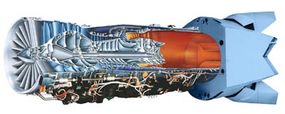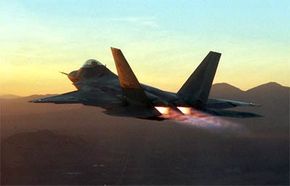Engines: Supercruise
Jet engines use afterburners to reach supersonic speeds. The afterburner is an attachment on the end of a jet engine that injects fuel into the exhaust to burn the oxygen left in the exhaust stream. The afterburner is an easy way to add power for short bursts, such as take-off or in a dog fight. But the afterburner consumes a lot of fuel. Fighter jets use the afterburner to fly faster than the speed of sound for long periods, but it decreases the range they can fly without refueling.
The F/A-22 is the first American fighter aircraft with the ability to supercruise, or fly at supersonic speeds without using the afterburner. In early flight tests, it sustained speeds of Mach 1.5 -- that's one and a half times the speed of sound -- without using the afterburner. It can reach Mach 1.8 using the afterburner.
Advertisement

The Raptor's two Pratt & Whitney F119-PW-100 engines pump out 35,000 pounds of thrust each (compare that to the 25,000-29,000 pounds of thrust for each engine on an F-15). Combined with the sleek aerodynamic design, the engines allow the Raptor to cruise at supersonic speeds with less fuel consumption than any other aircraft. That means the Raptor can fly faster for longer periods of time, reaching far-off targets faster than other jets. It can stay in an area looking for enemy targets longer or carry a bigger bomb load because it does not have to carry as much fuel.
